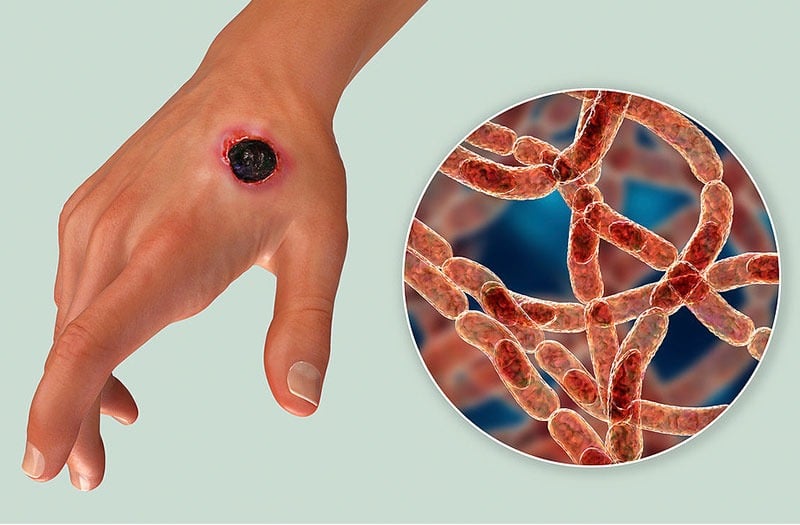On June 2, the Department of Preventive Medicine (Ministry of Health) sent an official dispatch to the Department of Health of Dien Bien province to direct the prevention of anthrax infection after 3 anthrax outbreaks occurred in the province, infecting 13 people.

One of the symptoms of anthrax is a black lesion on the skin.
According to a report from the Center for Disease Control of Dien Bien province, from May 5 to 30, in Tua Chua district, 3 outbreaks of cutaneous anthrax were recorded with 13 cases.
Of these, Muong Bang commune (1 outbreak) and Xa Nhe commune (2 outbreaks) have not recorded any deaths. All cases have an epidemiological history related to slaughtering and eating buffalo and cow meat.
Authorities also recorded 132 more people who had contact with or eaten meat from the three buffaloes and cows mentioned above. Symptoms include blisters and skin ulcers. Some people experienced headaches, stomachaches, diarrhea, difficulty breathing, and body aches.
To proactively prevent anthrax transmission from animals to humans, the Ministry of Health requires the Department of Health of Dien Bien province to closely monitor the health of those involved in slaughtering and using the same source of buffalo and beef as the above cases and those in close contact with the cases to prevent and treat promptly; strengthen monitoring, early detection of suspected cases of anthrax; handle the environment in the outbreak area according to regulations.
In addition, the Department of Health strengthens coordination with veterinary agencies and relevant departments and sectors in monitoring and detecting anthrax in animals to have timely preventive measures in humans; coordinates in investigating and handling anthrax outbreaks in animals.
Strengthen communication on measures to prevent anthrax transmission from animals to humans, paying special attention to high-risk areas and those who raise, trade and slaughter cattle. Advise people not to slaughter and use food from sick and dead cattle, horses or horses of unknown origin.
Direct local medical examination and treatment facilities to admit, isolate, and treat patients and promptly notify the disease control center to investigate and handle the outbreak.
In this dispatch, the Department of Preventive Medicine requested the Director of the National Institute of Hygiene and Epidemiology to direct, guide and support localities in investigating, monitoring and tracking suspected cases, cases in close contact with infected cases; and handling outbreaks according to regulations.
Provide guidance and support to local authorities in confirmatory testing of specimens from suspected human cases; consider training to improve local capacity in surveillance, detection, investigation and management of human anthrax outbreaks, and provide guidance in coordination with the veterinary sector.
Previously, in the communes of Xa Nhe and Muong Bang of Tua Chua district, there were outbreaks of anthrax. However, people were still subjective, did not report when buffaloes and cows died abnormally, but still slaughtered and sold meat. Specialized agencies and local authorities are implementing many activities to prevent and stop the spread of the disease.
Anthrax, also known as anthrax, is a group of infectious diseases caused by the gram-positive, rod-shaped bacterium Bacillus anthracis. This type of bacteria often exists in natural conditions, in soil or parasitizes domestic animals or wild animals.
When humans come into contact with animals that contain disease-causing bacteria, they can become infected and develop serious illness when the bacteria enter their bodies. Diseases usually enter the human body through contact routes such as: skin infection; respiratory infection; and digestive infection.
Source link



![[Photo] Prime Minister Pham Minh Chinh chairs the Government's special meeting on law-making in April](https://vstatic.vietnam.vn/vietnam/resource/IMAGE/2025/4/13/8b2071d47adc4c22ac3a9534d12ddc17)































![[Photo] Closing of the 11th Conference of the 13th Central Committee of the Communist Party of Vietnam](https://vstatic.vietnam.vn/vietnam/resource/IMAGE/2025/4/12/114b57fe6e9b4814a5ddfacf6dfe5b7f)





























































Comment (0)